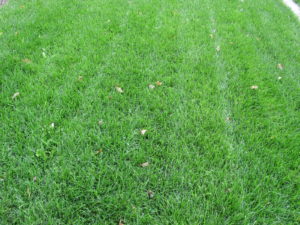“Summertime and the living is easy”. That’s a good adage to follow for home lawn care as well. Most lawn care chores, such as fertilizing, seeding, thatch management, and weed cleanup, should be delayed until late August through early October in most locales (USDA zones 4-7). During the heat of summer, proper mowing and irrigation are the only work necessary. Key to success is to raise the mowing height over the summer months.
Follow the one third rule. Remove no more than one-third of the grass height when mowing. Wait a few days to mow the lawn again. Scalping (close cutting) often results in a weak and weed infested lawn. If you miss a few scheduled mowings, don’t try to do it all at one time. Gradually reduce height of cut over several mowings. Don’t pick up the clippings as they contain nutrients that can be recycled as they decompose. Raked up clippings may be added them to the compost pile.
During the summer, mow cool season lawn grasses, such as Kentucky bluegrass, perennial ryegrass, and fine fescue, at heights around three inches or slightly higher. When in doubt, set the mower as high as it will go. Lawns maintained at higher heights usually develop deeper roots and dry out slower than closely mowed turf. Mulching mowers are a good investment as they are engineered to lift clippings and strike them several times before they are returned to the turf.
Cool-season lawn grasses naturally slow down and go dormant in the heat of summer. If you must irrigate, water lawns deeply at one time @ 1 to 1 1/2 inches per week. Water early in the day if at all possible. During periods of high stress, dormant lawns need only 1/4 to 1/2 inch of water every 2 to 3 weeks to keep root and crown tissue alive. Keep foot and vehicle traffic to a minimum if visible signs of drought are obvious.


 Posted in
Posted in 
